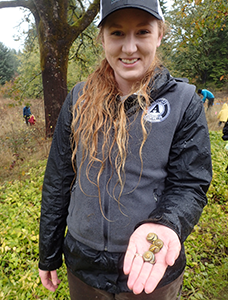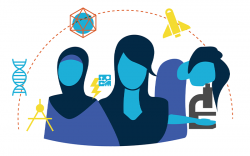Meet Aeriel Wauhob – Wildlife Biologist, Educator, and Notable Woman in STEM
We recently sat down (virtually) with Aeriel Wauhob, Education Coordinator at the Puget Sound Estuarium, to learn more about her career path and work as a biologist and educator. Read on to learn more about her career path.

I am an Education Coordinator at the Puget Sound Estuarium, which is a small marine life discovery center in Olympia. My job is to teach schools and private groups about estuaries, marine biology, animal ecology, and food webs. In the lab, we do experiments and talk about the different phenomena that happen in the estuary system, where salt and fresh water mix. We’re open to the public, so everyone can come here to learn. I also go to schools, nature preserves, and the beach to help people interact with the ecosystem and learn about how to be good land stewards so they can teach others. My job is to educate so they can then educate others too.
What was your education or career path? How did you get to where you are now?
From a young age, I always knew I wanted to do something with animals. I earned my wildlife biology degree at the University of Montana, then I had internships at the Dorothy Pecaut Nature Center in Iowa and the Rocky Mountain National Park. The internships helped me gain practical skills in environmental education. I learned how to interpret scientific knowledge for others. I also did internships at Bald Head Island in North Carolina; that’s how I got my start in marine biology. I learned a lot about endangered species and how water quality affects animals with the U.S. Fish and Wildlife Service in West Virginia. Water quality was what brought me to Washington, where I worked with South Sound Global Rivers Environmental Education Network (GREEN). That’s how I met the people at the Puget Sound Estuarium, where I became an Education Coordinator. My career path kind of just snowballed. I learned as I went, on the job or in internships— and not just from the job itself, but also from the really passionate people and volunteers. I learned what I wanted to do by actually doing it.
Who or what were some of your most important influences that guided you to STEM?
Early on, my mom and dad encouraged me to go outside to play in nature. I grew up on a small acreage in Iowa, where I was able to explore and learn about the plants and animals. Later, when I interned at the Rocky Mountain National Park, I worked with Jean Muenchrath, one of the head rangers. She is my inspiration. She shared her experiences so that you could feel comfortable when you made mistakes, because she let you know that she made mistakes too. She really helped propel me through the steps of how to build an education program, how to get the public really involved, how to build empathy. Because if they’re emotionally connected to the program then visitors will want to learn (and keep learning). Jean is a great inspiration and I hope I can live up to what she has done and fill her shoes in some capacity along the way.

What is your favorite part of your job?
I enjoy talking to people. Being able to share my enthusiasm, my knowledge, my passion with people is my favorite part of the job. I think that’s why, even though I have a wildlife biology degree that’s more scientific, I love to work on the education side, because I get to interact with the public. It’s validating and rewarding personally to have somebody get really excited about something that you personally love too. And I’m always learning. I love that too. I didn’t grow up around the ocean. I didn’t grow up around the sea, so I had to learn all about it. And I’m still learning today, especially when kids ask me questions.
What’s your biggest achievement?
I’m proud of the way the Estuarium was able to adapt during the global pandemic. I was inspired by my childhood idols like Jeff Corwin and Steve Irwin to create an online educational series to help reach people from across the country during the shutdown. People could still interact with science experiments and the beach through their computers. We were able to expand programming and start a STEM program with after school kids. The Estuarium doubled the number of people we reach through virtual programming. This last year, I was able to continue to share experiences and knowledge with people stuck at home.
Are there any stereotypes about women in stem that you want to address and dispel?
The education side of science seems more female oriented, but the scientific side is a lot more male dominated. That seems like, to me, something that should be addressed. It used to be a little discouraging, being the only female in the office or team. But the balance is changing. Women can do what our male counterparts can do. There’s nothing that can stop us. We’re equally as capable both mentally and physically to do these jobs, whether in education or research, in the office or out in the field. Girls need to see that women are here, in the workforce, challenging the stereotypes.
What unique qualities do you think girls and women bring to STEM fields?
Multitasking. I feel like at a young age it’s instilled in us that we need to be able to multitask, to be able to take care of everything going on around us and ourselves at the same time. I know that was how I felt, especially growing up with a younger sibling who I had to keep an eye on. Being able to work with people is another strength. We can jump into any sort of group and assimilate. We’re understanding and we have been raised to be empathetic.
Do you have any other advice for young women who might be thinking about STEM?
Try a lot of different things. At a young age, you don’t necessarily know what you want to do, so try anything and everything that might keep your interest. Explore all the different possibilities. If you don’t like it, that’s fine, move on. That’s what I did when I was younger. You’ll find what you like. Stick with it, build those skills and eventually they will lead into one job that you use all these skills for so. It just takes a little bit of initiative and being open to try something new. And you need to have the courage to fail. Allow yourself to fail at something, because that’s how we learn.
What do you think is unique about Washington in terms of STEM careers and opportunities in this state?
I’ve worked in every time zone in the continental United States and Washington is unique. Here, schools are teaching STEM education at a young age and there are some great STEM opportunities here. I think the schools here do a great job of connecting STEM education with the career opportunities too, connecting the science to the jobs, and then connecting them with actual people in those fields, which is just mind-blowing. Washington is a leader in how to integrate STEM education and expose kids to different career paths. And there are so many different career opportunities here in Washington.
Can you share a fun fact about yourself that we could share with our readers?
My name is Aeriel, but I was not named after the mermaid from the Disney film we all love! I do have red hair and I do work with sea life, but I am (unfortunately) not a true mermaid.